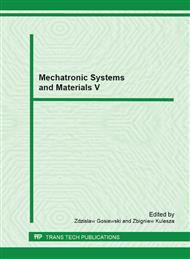p.137
p.143
p.149
p.155
p.159
p.165
p.170
p.176
p.182
Research on Tool Temperature Dependence on Lapping Grains Size
Abstract:
Commonly used as a finishing operation, lapping has been used for achieving ultra-high finishes and close tolerances between mating pieces. Its carried out by applying loose abrasive grains between work and lap surfaces, and causing a relative motion between them resulting in a finish of multi-directional lay. The grains activity (sliding and rolling) in the working gap causes not only the material removal but also the temperature rise of lap plate. This work presents the results of lapping plate temperature rise research. The investigation has been conducted to check the influence of grains size on. It was made during flat lapping with use of ABRALAP 380 lapping machine and infrared camera Thermo Gear G100. The lapping machine executory system consisted of three working conditioning rings. Plate temperature was measured during ceramic (Al2O3) elements lapping. The elements were valve sealing parts. After grinding they were processing with three abrasive grains sizes: F400/17, F800/6.5 and F1200/3. The abrasive mixture was boron carbide powder mixed with kerosene and machine oil with grain concentration 0.25. Other lapping parameters remained constant during process. The wheel speed was 60 rev/min and lapping pressure 0.04 MPa. In the next step the statistical analysis was conducted. It was analysed if the plate temperature is influenced by the grains size. A hypotheses testing method was use. Results were calculated for temperature rise values measured after 300 minutes of machine working. According to them the influence of abrasive grains size on plate temperature rise is statistically insignificant, what is not consisted with the model.
Info:
Periodical:
Pages:
159-164
Citation:
Online since:
March 2013
Authors:
Keywords:
Price:
Сopyright:
© 2013 Trans Tech Publications Ltd. All Rights Reserved
Share:
Citation:


